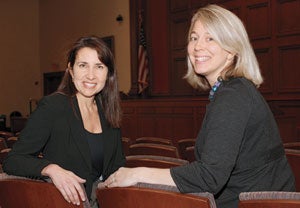The following story is from the February 2008 issue of Harvard Law Today
Few lawyers ever get the chance to write something that will be studied closely by a justice of the United States Supreme Court.
Even fewer get that chance more than once—a privilege that perhaps belongs to only a handful of Supreme Court practitioners, professors, law clerks, lower-court judges, and one or two others—including Meryl Kessler ’93 and Julie Barton ’92.
Barton is an adviser for joint- and concurrent-degree candidates at HLS, and Kessler, a former Climenko Fellow, has also worked as a career adviser at the school. Since 2005, however, they’ve collaborated on designing the hypothetical case that is argued in the annual Ames Competition—and that is scrutinized and deconstructed not only by the teams, but also by the three-judge panel that always includes a member of the Supreme Court. They also write two cases for the semifinal round of the competition.
“It’s nerve-racking,” says Kessler. “It’s like being a playwright and watching your play being performed, but with improvisation and unexpected turns.”
The case that is argued in the final round of Ames each November is the result of a process that begins the preceding May, when Kessler and Barton begin scouring federal appellate decisions that have produced splits of opinion between circuit courts. They try to stay away from cases that appear destined for the Supreme Court, however, to avoid any awkwardness for the justice who will sit on the panel.
“We look for issues where there’s good law on both sides,” says Barton.
By late summer, Barton and Kessler will draft a complaint and a set of facts—“every fact must have a bearing on what the judges will ask,” says Barton—plus a record of exhibits, motions, relevant regulations or statutes, and administrative or lower-court opinions. They are careful to differentiate their case from real ones so the students can’t rely too much on the briefs and arguments in reported decisions.
“It’s great to work as a team,” says Kessler, “because it would be extremely challenging for just one lawyer to anticipate all the possible moves that these students and judges will make.”
In early September, the Board of Student Advisers distributes the case to the finalists, who have a week to “kick the tires” and ask for clarifications. After Kessler and Barton make any needed adjustments, the record is complete. Their final task is to write a 20-page bench memo for the judges.
When Barton asked Justice David Souter ’66 at a reception before the 2005 argument if he found the bench memo helpful, he politely explained that he didn’t need much more than a one-page summary with bullet points. “But other panelists have told us the memo is valuable,” says Barton, laughing. “So I guess we’ll keep doing it.”
